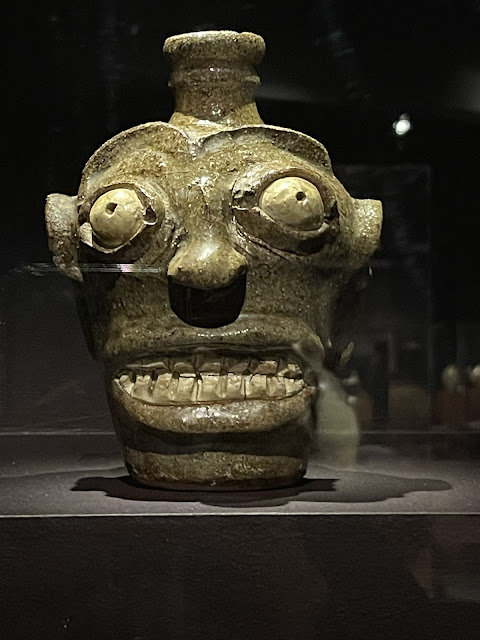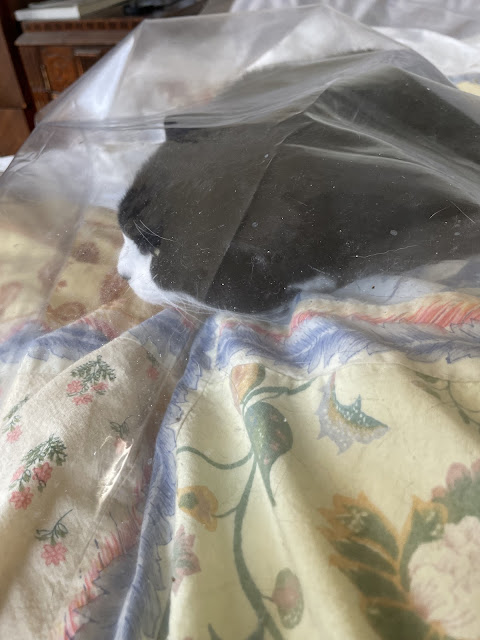Day 66, May 21, 2020
Greed
(A continued mediation on the 7 Deadly Sins)
How does one differentiate greed from gluttony? Greed seems distasteful. But greed is tied to desire. Desire seems like a force of passion, even if it may result in greed or gluttony.
I remember in middle school, in-between school assemblies about MX missiles, school dances, and someone's dad parking a DeLorean car outside for all the kids to gawk over, we had economic reality checks given by our teachers warning us that we were the first generation where it was projected that we would not earn more than the previous generation, and in all likelihood we would not experience the same standard of living we were experiencing as children. I'm not really sure what kind of inspiration we were supposed to draw from that information when puberty and Michael Jackson was breaking over all of us. But, for all these years, that, along with a 30-45 second wait for vaporization if Boston was hit by a nuclear warhead, has been retained in my memory.
 |
| Shrubbery in bloom. |
In 8th grade we had a school trip to Washington DC. One can only imagine the logistics of loading two hundred and fifty eighth graders, their teachers, and chaperones onto charter busses. There are a couple of things that stand out in my memory. The first is that I carried a Kodak disc camera with me. It was a thin, severely limited contraption, that utilized film loaded into cartridges that eliminated the danger of exposing the film when loading or unloading a roll. I was a fanatic, and on that trip must have shot 8 or 9 cartridges of film, at least. But I never developed any of them. For years they sat in a shoebox tucked into the bottom of my bookshelf in my bedroom. I thought about the photos from time to time, I could remember the urgency I experienced of having to capture all of those images, and for many, I could even remember the image in the primitive viewfinder. But, upon returning home, the sheer volume of the cartridges was intimidating. Back then, there were these companies that gave you special mailers with check box ordering forms on the outside. You would fit one or two rolls or cartridges of film inside, and a few weeks later you would get your photos delivered to your mailbox with more mailers for the next rolls. But what would you do with 10 rolls of film, or more? And what if the first set was disappointing, would it be worth it to send in more? I had felt the need to capture so much of what I saw, and yet, I never gave myself the opportunity to realize that vision. Instead, the film wasted away, decayed over years, and eventually they were discarded as obsolete media.
I also remember someone, I think John, brought along a boombox on the charter bus I was on. At the time, carrying music with you was a kind of novel thing. This was before iPods or the Walkman, there were transistor radios with one ear bud for mono monitoring. But a boombox, with a bevy of D-size batteries, was a marvelous thing. I do not recall if there was only one cassette, or if that one cassette was the only one everyone could agree on listening to, but for whatever reason, The Big Chill soundtrack was the only thing we listened to all the way from a suburb of Boston to the nation's capital. Even now, I can sing all the words to "Joy to the World" by Three Dog Night, "I Heard it Through the Grapevine" by Marvin Gaye, "My Girl" by the Temptations. All those tunes were seared into my impressionable mind like another language. We all sang along in the wildly raucous way 8th graders do. At some point, our bus was pulled over for speeding and the bus driver cracked and yelled at us all, and the boombox was confiscated. For a period of time, there was only silence, the hushed whispers of chastised children, and then, after a time, the bus driver must have relented because we had the boombox back and we played "You Make Me Feel Like a Natural Woman" until the second set of batteries died. Our appetite was insatiable. A craving for Motown was awakened in these suburban kids and you would have thought we had all grown up in the clutches of Berry Gordy's empire. Only the failure of battery technology thwarted our desire to be one with song.
But, those two things are really minor trivial things to the main memory I have of that trip. We stopped to see the, still relatively new, Vietnam War Memorial. I had no idea of what to expect, but as we disembarked from the bowels of the bus and swarmed in the direction of the obsidian black walls, I was overcome with emotion. As my peers ran back and forth as if they were out on recess, I could not fathom the expanse of names, how every name etched in the granite represented a human being who no longer existed on this Earth. I walked along trying to read every name, to pay each individual a degree of respect. At various locations, there were thick binders filled with laminated sheets that duplicated the names on the wall to help people find the precise location of a person. I leafed through the pages astounded by the sheer volume of names. And then, at various places along the wall there were teddybears, flowers, mementos, and I started to cry. Once I started to cry, I was unconsolable. My teachers didn't know what to do, were totally unprepared for my response. My classmates whispered that I must have known someone. But the truth is, I didn't know anyone. The only person I knew connected with the war was my friend Andy Miller, whose dad was a veteran and whose best friend had lost his legs in the war and visited the house in a wheelchair. But, I knew the Vietnamese were Asian like me. I knew it was a terrible and tragic war and that many people had died. I had played war in the back yard with plastic guns, toy grenades that you could load with strips of gun powder impregnated paper that popped when you threw it just right. I had played with the little green soldiers in Billy's basement, only I always had to use the mustard yellow soldiers because they were Asian, like me. Billy had hundreds of these little plastic men, set upon set combined into massive armies in his basement. And yet, none of that was close to the scale that was represented on the wall. It did not register to me as American or Vietnamese, or winners or losers, all that registered was the immense loss of life, that this was something we humans had inflicted upon ourselves and it was terrible. I could not fathom how something like this could happen, that people would choose to engage in such wanton destruction, and how the only way one could justify such actions, was greed.
 |
| A Jack-in-the-Pulpit (thanks Amanda!) |
I guess there is one last prominent memory from that trip. Once we were released in the Mall, we each had a thick sheaf of worksheets that we needed to complete by visiting each of the Smithsonian museums. In the Smithsonian Museum of Natural History there is the Hope Diamond. I pressed against the glass case with my worksheet and pencil, scratching in answers in the fill-in-the blank sections. This very stone had been ordered cut by Louis XIV. That seemed astounding. While my friends and I worked there was a sudden flurry of security guards and a discrete bell tolling. Eventually one of the security guards caught me by the arm and pulled me away from the case before radioing his compatriots that he had apprehended the thief. Apparently, my pencil transmitted a vibration through the paper, into the glass, which in turn triggered a surprisingly sensitive alarm designed to protect this cursed gem that had been the object of insatiable desire, the diadem of excessive wealth, the cause of folly and misfortune. So, I can brag to friends, I once set off the alarm of the Hope Diamond at the Smithsonian.
There was a time that I imagined myself living an unencumbered life of an aesthetic. The Beat Poets I once read, allowed themselves to own seven things. When we were in college, my roommate Claiborne, prided himself in being able to fit everything he owned in the back of his little Toyota pickup truck. I imagined a simple existence. Of course, things change. We become accustomed to certain extravagances. We become attached to guitars, books, particular pillows, a favorite t-shirt, and before you know it, a house is filled to capacity. There are too many t-shirts to close the drawer; one needs a larger bed to accommodate all the pillows, but in the meantime, at least one falls to the floor each night; there are no more free spaces to accommodate more books that you once read and adored, or plan to read when there is time and capacity. And, of course, there is no room for any more guitars. This is where greed has gotten us. Just a tiny bit at a time, little moments of excess, succumbing to the idea that I would like another pair of sneakers, or that buying a record at a tag sale is saving the music from oblivion. The house has become a negotiation, where something must be eliminated before taking on something else. Objects must be thrown away, gifted, sold, or bequeathed to the Smithsonian before anything else can be added.
Greed.
Leo
 |
| A couple of hungry girls. |
From Our Friends:
From Common Good:
During this economic crisis, would it help you to have some extra spending money, that incurs no interest and that you don’t have to pay back anytime soon? If so, please speak up by replying to this email. To be eligible, reply <info@CommonGood.earth>by Friday, May 22 with answers to these questions:
- What is your full name?
- Where do you live (city or town)?
- What is the minimum amount of credit that would make a significant difference for you?
- How long would you need to pay it back (number of months)?
- In a few words, how would this credit help you?
- How would you like to be contacted when a decision has been made about your application?
- (Optional) Would you like to use this money to shop at businesses that are not currently Common Good members? If so, please list them (here's a current list of participating businesses).
From the Northampton Jazz Workshop:
1. Here's how some friends from the Hartford area are keeping the music alive: on Friday May 22nd: 10th Free Friday Feelgood Concert of 45 minutes by Saskia Laroo and Warren Byrd aka Duo Laroo/Byrd, Live and Streamed
2.Saturday, May 23rd: Scullers "Living Room LIve Series" Presents Karrin Allyson - 7:30-8:30 on FB. https://www.facebook.com/events/240058657094628
3. And don't forget; Vermont Jazz Center is streaming a presentation by TERRI LYNE CARRINGTON in concert and teaching on May 23 @ 8:00 pm - May 24 @ 5:00 pm https://vtjazz.org/upcoming-events/concerts/
2.Saturday, May 23rd: Scullers "Living Room LIve Series" Presents Karrin Allyson - 7:30-8:30 on FB. https://www.facebook.com/events/240058657094628
3. And don't forget; Vermont Jazz Center is streaming a presentation by TERRI LYNE CARRINGTON in concert and teaching on May 23 @ 8:00 pm - May 24 @ 5:00 pm https://vtjazz.org/upcoming-events/concerts/
From NEPR:
Presented by WCRB Classical Radio Boston, cellist Yo-Yo Ma will perform J.S. Bach’s six cello suites live from the studios of public media producer WGBH on Sunday, May 24 at 3 p.m, as a memorial for those we have lost in the pandemic and a tribute to the resilience of our communities.
This performance comes during what would have been the now-postponed final leg of Ma's The Bach Project, a 36-stop, six-continent tour of the complete cello suites. The Project is part of a larger conversation about how culture can help us to imagine and build the world we want. Hosted by Brian McCreath of WCRB, host of the Boston Symphony Orchestra broadcasts, Sunday’s 2.5-hour performance will air live and uninterrupted in western New England on NEPR 88.5 FM. It will also be available for live streaming at nepr.net and on Yo-Yo Ma’s YouTube channel.
From It Gets Better:
Join Your Favorite Queer Writers on Instagram Live
Join us every Tuesday at 12pm PT onInstagram Live for a conversation, reading, and Q&A with writers like Casey McQuiston (pictured). Check our schedule for upcoming chats.
From Dr. Caroline Shenaz Hossein, York Univ. via the Community Economies Resource Network:
Sharing this recording (see below) of a session on Community Capital and the African diaspora in the Time of Covid-19. Please share with others. Black women scholars who are part of Solidarity Chicago- Renee Hatcher, Stacey Sutton and Amara Enyia organized this session. So many other terrific folks also assisted in this work.
The three speakers were
JESSICA GORDON NEMBHARD, CUNY
NIA EVANS, UJIMA BOSTON
CAROLINE SHENAZ HOSSEIN, YORK UNIVERSITY, TORONTO
Here is the link. https://youtu.be/xCZGe_28WWA
From the American Association of Geographers:
Carbon emissions worldwide are poised to see the largest decrease since World War II thanks to global stay-at-home orders due to the pandemic. [T]his is an unprecedented drop," says Glen Peters, co-author of a study in Nature Climate Change, who also notes "it basically makes no difference at all" due to the cumulative nature of climate change.
Full Story: New Scientist (free content) (5/19)
From ERSI:
| The New Learn ArcGIS Hub is Here! | ||||
|
 |
| Chives |
Today's Online Teaching Tips:
From LinkedIn:
From Campus Compact:
|
|
From Kaltura:
| ||||||||||




Comments
Post a Comment